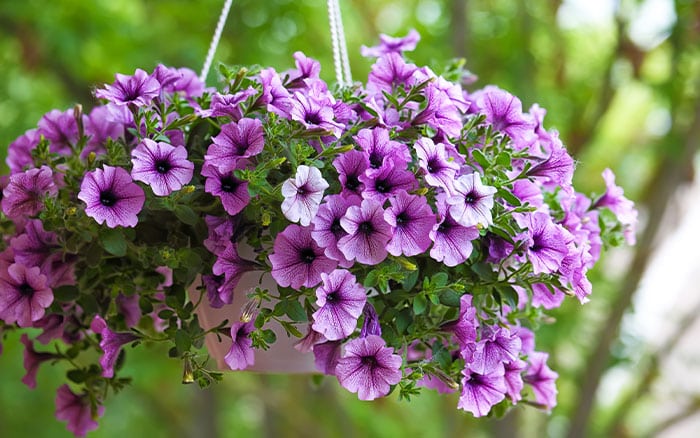Petunias are a gardener’s dream for injecting vibrant colour and fragrance into borders, hanging baskets, and containers. I’ve seen these South American natives become a staple of British summer gardens.
In this guide, find out techniques to successfully grow petunias in your garden.
Understanding petunias
Petunias (Petunia x atkinsiana) are members of the Solanaceae family, making them relatives of tomatoes and potatoes. Developed from wild species native to Argentina, Brazil and Uruguay, modern hybrids offer a kaleidoscope of colours and forms, including grandifloras, multifloras, millifloras, and trailing types like the popular ‘Surfinia’.
Whilst petunias are technically tender perennials, they are grown as annuals in the UK due to their frost sensitivity. Their trumpet-shaped flowers and velvety foliage are magnets for pollinators. Particularly for bees and moths. In addition, petunias are known to attract nocturnal pollinators, thanks to their scent and floral structure.

Sowing or planting from plugs
You can grow petunias from seed or from plug plants. Sowing from seed in late January to March gives you access to a wide range of varieties.
Step-by-step seed sowing:
- Use a heated propagator set to around 21°C for optimum germination requirements.
- Fill seed trays with a fine, peat-free, seed compost, and scatter the seeds thinly on the surface.
- Don’t cover the seeds, as they need light to germinate successfully.
- Mist the trays with water and cover with a clear lid or polythene. This helps to retain humidity.
- Germination should occur within 7 to 14 days. Once seedlings have developed true leaves, pot them into individual modules.


Planting outdoors
Petunias are frost-tender, so harden them off for 7-10 days before planting out in late May or early June.
- Choose a sunny spot, as these plants need at least six hours of direct sunlight daily.
- Use a well-draining, fertile soil. If you’re planting in beds, enrich the soil with well-rotted compost.
- For containers, use a quality multi-purpose peat-free compost with added slow-release fertiliser.
- Space upright varieties 20-30cm apart, and trailing types 30-40cm apart to allow room for growth.
Feeding and Watering
Petunias are hungry plants. Studies have shown they respond particularly well to potassium-rich fertilisers.
- Once flowering starts, feed weekly with a liquid fertiliser high in potassium.
- Water regularly, especially in containers, where compost can dry out quickly in the summer. Always water at the base to avoid fungal issues on foliage.
Deadheading and pruning
Deadheading spent flowers prevents seed formation, encouraging continuous blooming.
- Pinch off any faded blooms and seed pods to direct the plant’s energy into new flower production.
- For leggy growth mid-season, cut back stems by a third to stimulate bushy regrowth and more flowers.

Pest and Disease Management
Avoiding chemical controls is not only better for beneficial insects but also promotes natural balance in your garden. Petunias are susceptible to aphids, whitefly, and botrytis (grey mould).
- Encourage ladybirds and hoverflies to tackle aphids.
- Use sticky traps or introduce companion plants like marigolds to deter whitefly.
- For fungal issues, ensure good air circulation and avoid overhead watering. Remove infected material promptly.
Overwintering and propagation
Although petunias are annuals in the UK, you can take cuttings in late summer to overwinter indoors:
- Cut 7-10cm healthy non-flowering shoots.
- Remove lower leaves and dip in organic rooting gel.
- Insert into a gritty, peat-free compost mix.
- Place in a propagator or under a clear cover in a bright location out of direct sunlight.
This method ensures early flowering plants the following spring.
With their bold colours, cascading growth, and sweet scent, petunias are a key feature for summer gardens. By understanding their needs, you can enjoy a spectacular display from late spring through to the first frosts.
For more great gardening advice, make sure you head to my YouTube Channel. Make sure you’re subscribed with notifications on so you don’t miss any of my new videos.
Frequently Asked Questions
1 – How do you grow petunias from seed in the UK?
Sow petunia seeds indoors from late January to March using a heated propagator set to around 21°C. Do not cover the seeds, as they require light to germinate. Keep compost moist and transplant seedlings into modules once they have developed true leaves.
2 – When is the best time to plant petunias outdoors?
Plant petunias outdoors in late May or early June, once all danger of frost has passed. Harden off plants for 7–10 days before planting in a sunny, sheltered location with well-drained soil.
3 – How often should petunias be watered and fed?
Water petunias regularly, especially in containers where compost dries quickly. Feed weekly with a potassium-rich liquid fertiliser once flowering begins to encourage abundant blooms throughout the season.
4 – How can you keep petunias flowering all summer?
Deadhead faded blooms regularly to prevent seed formation and stimulate new flowers. For leggy plants, cut stems back by a third mid-season to encourage bushy regrowth and more blooms.
5 – Can you overwinter petunias in the UK?
Petunias are grown as annuals in the UK, but cuttings can be taken in late summer. Root them in gritty compost indoors to produce healthy early-flowering plants for the next year.

Leave A Comment